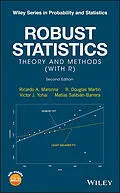A new edition of this popular text on robust statistics, thoroughly updated to include new and improved methods and focus on implementation of methodology using the increasingly popular open-source software R.
Classical statistics fail to cope well with outliers associated with deviations from standard distributions. Robust statistical methods take into account these deviations when estimating the parameters of parametric models, thus increasing the reliability of fitted models and associated inference. This new, second edition of Robust Statistics: Theory and Methods (with R) presents a broad coverage of the theory of robust statistics that is integrated with computing methods and applications. Updated to include important new research results of the last decade and focus on the use of the popular software package R, it features in-depth coverage of the key methodology, including regression, multivariate analysis, and time series modeling. The book is illustrated throughout by a range of examples and applications that are supported by a companion website featuring data sets and R code that allow the reader to reproduce the examples given in the book.
Unlike other books on the market, Robust Statistics: Theory and Methods (with R) offers the most comprehensive, definitive, and up-to-date treatment of the subject. It features chapters on estimating location and scale; measuring robustness; linear regression with fixed and with random predictors; multivariate analysis; generalized linear models; time series; numerical algorithms; and asymptotic theory of M-estimates.
- Explains both the use and theoretical justification of robust methods
- Guides readers in selecting and using the most appropriate robust methods for their problems
- Features computational algorithms for the core methods
Robust statistics research results of the last decade included in this 2nd edition include: fast deterministic robust regression, finite-sample robustness, robust regularized regression, robust location and scatter estimation with missing data, robust estimation with independent outliers in variables, and robust mixed linear models.
Robust Statistics aims to stimulate the use of robust methods as a powerful tool to increase the reliability and accuracy of statistical modelling and data analysis. It is an ideal resource for researchers, practitioners, and graduate students in statistics, engineering, computer science, and physical and social sciences.
Autorentext
Ricardo A. Maronna, Consultant Professor, National University of La Plata, Argentina
R. Douglas Martin, Departments of Applied Mathematics and Statistics, University of Washington, USA
Victor J. Yohai, Department of Mathematics, University of Buenos Aires, and CONICET, Argentina
Matías Salibián-Barrera, Department of Statistics, The University of British Columbia, Canada
Inhalt
Note: sections marked with an asterisk can be skipped on first reading.
Preface xv
Preface to the First Edition xxi
About the Companion Website xxix
1 Introduction 1
1.1 Classical and robust approaches to statistics 1
1.2 Mean and standard deviation 2
1.3 The three sigma edit rule 6
1.4 Linear regression 8
1.4.1 Straight-line regression 8
1.4.2 Multiple linear regression 9
1.5 Correlation coefficients 12
1.6 Other parametric models 13
1.7 Problems 16
2 Location and Scale 17
2.1 The location model 17
2.2 Formalizing departures from normality 19
2.3 M-estimators of location 22
2.3.1 Generalizing maximum likelihood 22
2.3.2 The distribution of M-estimators 25
2.3.3 An intuitive view of M-estimators 28
2.3.4 Redescending M-estimators 29
2.4 Trimmed and Winsorized means 31
2.5 M-estimators of scale 33
2.6 Dispersion estimators 35
2.7 M-estimators of location with unknown dispersion 37
2.7.1 Previous estimation of dispersion 38
2.7.2 Simultaneous M-estimators of location and dispersion 38
2.8 Numerical computing of M-estimators 40
2.8.1 Location with previously-computed dispersion estimation 40
2.8.2 Scale estimators 41
2.8.3 Simultaneous estimation of location and dispersion 42
2.9 Robust confidence intervals and tests 42
2.9.1 Confidence intervals 42
2.9.2 Tests 44
2.10 Appendix: proofs and complements 45
2.10.1 Mixtures 45
2.10.2 Asymptotic normality of M-estimators 46
2.10.3 Slutsky's lemma 47
2.10.4 Quantiles 47
2.10.5 Alternative algorithms for M-estimators 47
2.11 Recommendations and software 48
2.12 Problems 49
3 Measuring Robustness 51
3.1 The influence function 55
3.1.1 *The convergence of the SC to the IF 57
3.2 The breakdown point 58
3.2.1 Location M-estimators 59
3.2.2 Scale and dispersion estimators 59
3.2.3 Location with previously-computed dispersion estimator 60
3.2.4 Simultaneous estimation 61
3.2.5 Finite-sample breakdown point 61
3.3 Maximum asymptotic bias 62
3.4 Balancing robustness and efficiency 64
3.5 *Optimal robustness 66
3.5.1 Bias- and variance-optimality of location estimators 66
3.5.2 Bias optimality of scale and dispersion estimators 66
3.5.3 The infinitesimal approach 67
3.5.4 The Hampel approach 68
3.5.5 Balancing bias and variance: the general problem 70
3.6 Multidimensional parameters 70
3.7 *Estimators as functionals 72
3.8 Appendix: Proofs of results 76
3.8.1 IF of general M-estimators 76
3.8.2 Maximum BP of location estimators 76
3.8.3 BP of location M-estimators 77
3.8.4 Maximum bias of location M-estimators 79
3.8.5 The minimax bias property of the median 80
3.8.6 Minimizing the GES 80
3.8.7 Hampel optimality 82
3.9 Problems 85
4 Linear Regression 1 87
4.1 Introduction 87
4.2 Review of the least squares method 91
4.3 Classical methods for outlier detection 94
4.4 Regression M-estimators 97
4.4.1 M-estimators with known scale 99
4.4.2 M-estimators with preliminary scale 100
4.4.3 Simultaneous estimation of regression and scale 102
4.5 Numerical computing of monotone M-estimators 103
4.5.1 The L1 estimator 103
4.5.2 M-estimators with smooth 𝜓-function 104
4.6 BP of monotone regression estimators 104
4.7 Robust tests for linear hypothesis 106
4.7.1 Review of the classical theory 106
4.7.2 Robust tests using M-estimators 108
4.8 *Regression quantiles 109
4.9...
